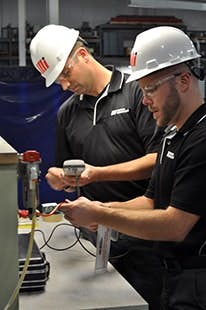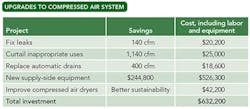Chemical manufacturers in their ongoing quest to remain competitive are giving energy efficiency and sustainability projects a much higher priority. Such projects can reduce operating costs, cut greenhouse gas emissions, improve systems and hedge against future energy costs. However, upfront costs often pose a major barrier. Many companies don’t have the capital available to pay for the equipment, installation and servicing of energy efficiency projects out-of-pocket. Even those with the capital may prefer instead to spend it on their core operations — what they know best.
When contemplating efficiency projects, operating companies typically have three general options: self-funding (cash); using traditional financing tools (e.g., a lease or loan); or opting for one of the “specialty” financing tools that have sprouted up for such projects. Here, we’ll take a closer look at these specialty tools.
One of the most popular is efficiency-as-a-service. This is a pay-for-performance, off-balance-sheet, financing option that allows companies to implement their energy efficiency projects with no upfront capital expenditure. The energy services agreement (ESA) is the most common type of this arrangement. In it, the provider pays for the project’s development, equipment and installation as well as ongoing maintenance and service costs. The vendor assesses the operation and determines achievable improvements in performance or energy savings to stipulate in the agreement (Figure 1). Once the project is operational, the operating company makes service payments based on these agreed-upon performance or energy efficiency values.
In other words, with an ESA, a chemical maker can redirect a portion of its current utility spend and utilize “savings” to pay for efficiency improvements. This works because ESA payments are based on realized energy and operational savings and are set below the current utility price.
Figure 1. An energy service technician describes the results of an assessment and improvements possible via an ESA.
Compelling Advantages
An operating company can reap a variety of benefits from opting for an ESA:
No upfront capital requirements. Self-funding and traditional financing require significant upfront capital. When paying cash, a company typically must pony up 50% of the project cost on the front end with the remainder due upon project completion. When financing through traditional tools, a firm often must pay 10% upfront or at least a minimum of a couple of months’ payments and closing costs.
In contrast, in an ESA, payment to the provider isn’t due until the project is operational and the savings have begun. This truly allows you to “redirect” payments that you would have been making to the utility and only send an agreed-upon portion of your realized savings to the provider.
Off the balance sheet. After five years of efforts, the Financial Accounting Standards Board issued an accounting standards update that greatly impacts the booking of leases. Those changes went into effect for U.S. public companies on December 15, 2018, and will apply to all other organizations on December 15, 2019. The result is that ESAs are one of the few remaining tools that offer the ability to book projects/efficiency programs off the balance sheet.
Immediate cut in operating expenses. By structuring an energy-reducing, cost-saving improvement in the form of an ESA, chemical makers immediately can see a decrease in expenses. For example, a company will see a monthly cash flow improvement of $5,200 if its electricity bill drops by $10,000/mo and its ESA requires payments of $4,800/mo.
No risk regarding performance. Typically, the efficiency and cost-reducing numbers evoke excitement at an operating company. However, executives often have an unspoken concern about the feasibility of the attractive return on investment (ROI) indicated.
With an ESA, an operating company needn’t worry about whether the saving projections are real. The ESA provides protections for the firm by stating what the numbers must be and either setting payments as a percentage of the savings or, in some cases, guaranteeing via third-party insurance that the company gets the stipulated savings. The risk now resides with the vendor and insurer, not with the chemical maker. ESAs and other specialty service agreements offer this peace of mind.
Freedom from maintenance responsibilities. Many efficiency projects or programs require ongoing monitoring and maintenance. By utilizing an ESA, an operating company can ensure that the vendor handles these duties. The company can focus on its core business and not worry about placing extra demands on its maintenance team.
ESAs or specialty service agreements are increasing in popularity. They can apply to any operation where you can measure performance and savings, including:
• Compressed air systems;
• Steam systems;
• Equipment and process controls;
• Motors and pumps;
• Refrigeration systems;
• Boilers and furnaces;
• On-site cogeneration systems;
• Heating, ventilation and air conditioning systems;
• High-efficiency lighting; and
• Building automation systems.
Avoiding Surprises
Let’s assume you’re not only convinced of the value of entering into an ESA but also have found a contractor prepared to provide the equipment and improved efficiency that you need, handle installation, commit to ongoing maintenance and, through the use of an ESA, fund all of this with future savings. What could go wrong? Without the right partners and a properly worded and scoped ESA, you could wind up with some unpleasant surprises. You must pay attention to and thoroughly understand four areas prior to signing on the dotted line.
Figure 2. In-line hygrometer indicates the dewpoint of compressed air, which is part of assessing its operating condition.
1. Is this the right partner and ESA for the long term? Achieving enduring energy savings requires a long-term focus. With changing technologies and market conditions, contractors and vendors come and go. Before you enter into a 5-, 10- or even 20-yr contract, think about whether your prospective partners are going to be around for the long haul. Carefully look at their length of time in business, track record, financial strength and, where appropriate, licensing. Strategy is important. Execution is even more important.
2. Do you have a detailed breakdown of all costs for equipment and installation? Have you moved beyond estimated savings and drilled down to the real numbers? Do you have a detailed accounting for the equipment that will be installed? Does your agreement account for all labor? It’s important to have final numbers before you commit to a long-term contract.
3. Does the ESA properly cover ongoing maintenance? When setting a long-term strategy, ongoing maintenance is a key component. Is there a plan or procedure for dealing with equipment failure either immediately or five and ten years into the contract? Does the ESA specify ongoing monitoring or periodic equipment checks? A strong contract will address ongoing maintenance and guarantees for both equipment and labor.
4. Does your vendor and ESA provide for adequate ongoing measurement and verification? A thorough grasp of how the numbers for savings have been generated and how numbers will be measured and quantified is also very important. Does your contractor adhere to and employ the International Performance Measurement and Verification Protocol (see: http://bit.ly/2TvZfPK) to determine actual energy savings? Does its billing comparison methodology consider the entire installation and interactive effects before and after installation? Understanding your vendor’s methodology is key in understanding your long-term savings.
Real-World Examples
To better illustrate when and where an ESA can work, let’s look at two cases relevant to process plants that I have been involved in.
In the first, my energy services team was called in to “map” a plant’s compressed air system and analyze its process from start to finish. (Compressed air is an expensive utility, see: “Upgrade Compressed Air Systems.”)
The team assessed both the supply and demand side of the system (Figure 2). We identified the demand-side waste and made recommendations for steps essential to reduce the overall system demand in the future (Table 1). As a result of these improvements, the plant would be able to meet the future demand by replacing the existing compressors with more-efficient ones equipped with an alternative type of control. This would yield an overall system savings of about $494,000 annually.
Table 1. Service agreement yielded a net positive cash flow of more than $300,000/yr.
Under the 48-mo ESA, each month the operating company paid ≈$16,100 to realize a savings of ≈$41,200, resulting in a net positive cash flow of more than $25,000.
In this case, the ESA was selected for multiple reasons. First, the plant would be able to realize immediate savings to its operating budget from the time of the install without having to put up the $632,200 of capital. Second, the ESA agreement guaranteed the expected savings of $41,000/mo. Finally, it provided 48 months of ongoing monitoring and any necessary maintenance.
Plants also often struggle with inefficiencies in another important and expensive utility — steam. So, now let’s look at a case the team handled that addressed replacing steam traps and improving steam system efficiencies.
Our audit and analysis found that 13% of the steam traps were failing annually. We suggested a 10-yr ESA (divided into two 60-mo segments) that would cover replacing all 817 traps and their ongoing monitoring. It required no upfront capital from the operating company for the $859,000 cost (including all labor and equipment) for replacing the traps, and provided ten years of guarantees.
During the first 60-mo portion of the ESA, the operating company paid ≈$17,400 each month and saved ≈$29,900 in steam, resulting in a net positive cash flow of ≈$12,500/mo. On an annual basis, the steam savings exceeded $359,000 and the improvement in cash flow topped $150,000. During the second 60-mo period, the guaranteed steam savings rose even higher, resulting in a >$29,000/mo improvement in cash flow.
An Attractive Option
ESAs may be a good fit for your company. While they won’t displace paying cash or using traditional financing options for all applications, they’re worth evaluating if:
• You want to pursue retrofits across your portfolio without spending your own capital.
• You prefer off-balance-sheet treatment for the delivery of efficiency services.
• You like the idea of pay-for-performance where a third party takes on the performance risk and provides project management and maintenance. You pay for exactly what’s delivered — nothing more, nothing less.
• You seek a strategy that provides operating budget relief immediately.
• You desire to procure energy-efficient technologies across your portfolio without the hassle of ownership.
In such situations, do three things. Interview and vet a properly qualified and trusted vendor or partner. Assess what areas in your processes might allow improved efficiencies while saving significant money. Finally, discuss whether gaining savings without accessing capital budgets would work for you.
For many companies, it’s time to take a closer look at ESAs.
CHRIS YURKO is an energy services and financing specialist for the Energy Services Team of Motion Industries, Birmingham, AL. Email him at [email protected].



